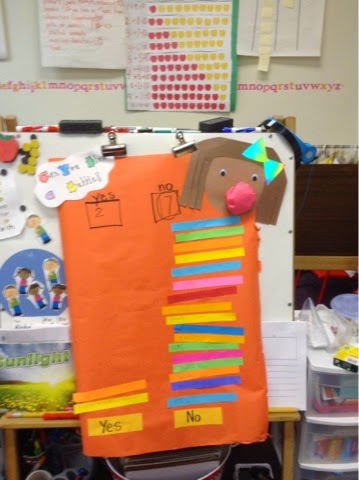Thursday, May 21, 2015
Tuesday, May 19, 2015
Sunday, May 17, 2015
Engineering Task to finish our unit on Weather and Climate
Leading up to our task...
Students had daily experiences that intentionally provided information that helped with the design of the structure.
- On Monday, students observed and compared a cup of water in the sun vs. a cup of water covered with saran wrap in the sun. How does the Sun impact the cups?
- On Tuesday, students compared how the Sun impacts a variety of the Earth's surfaces (rocks, soil, water, ice and sand). Which surface was warmer or cooler? Why? (K-PS3-1).
- Students blocked the Sun's rays by creating shadows. (This proved to really be valuable when students positioned their structures outside.) (K-PS3-1),(K-PS3-2) I can identify an observable pattern when something comes between the Earth's surface and the sun.
- Students "toured" a variety of Earth's surfaces with Google Earth. What did you notice?
- Students compared the impact of the Sun with light/dark/shiny surfaces. What absorbs or reflects the sun's energy?
- Students identified real objects they knew that help reduce the sun's light from shining. (umbrella, roof, sunglasses, tent)
- Read many books on the Sun. Here are a few that we explored.
On Thursday, students were presented with the following task:
People get hot sitting in the sun for long periods of time. Your team has been hired to engineer a structure that will reduce the warming effect of sunlight on an area.
Students got into teams of 2-3. They had to brainstorm ideas that they thought would be best to reduce the warming effect of the sun on a cup of ice that would be under their structure. (I loved it when I overheard a student say, "We have to get a piece of dark felt" before even seeing the materials. Loved hearing the planning, thought, and reasoning.)
Then, the groups were presented with a variety of materials. Some that are shown below. Light/dark fabric, craft sticks, saran wrap, foil, tape, blocks, etc..
Let the building begin...
When the group below first had their structure out, several people kept asking them to turn their structure so that the "arch" was how you see here. But at the beginning they had the arch away from the sun. Once the sun (finally) came out and the group could see the shadow, they turned the structure so that the "arch" created a shadow to protect the cup. At first, when the group chose the saran wrap, I thought it was an odd choice to have it exposed and not covered. The group remembered from an earlier lesson that the water cup that was covered retained more water than the cup without saran wrap. They were thinking!
So apparently, I timed it better last year when I first did this lesson. When we went out to check our structures, you could clearly see which structure reduced the warming effects on the cup of ice. But with the high temps and humidity on Friday, we were too late! The ice had melted in all cases. Unfortunately, the rain was moving in otherwise we would have replaced the ice and tried it again for less time. Even without a "clear winner" the vocabulary, application and process was one of our best science discoveries of the year!
Constructing explanations and designing solutions in K–2 builds on prior experiences and progresses to the use of evidence and ideas in constructing evidence-based accounts of natural phenomena and designing solutions.
•Use tools and materials provided to design and build a device that solves a specific problem or a solution to a specific
problem. (K-PS3- 2)
Many other cross cutting concepts were integrated as well!
Wednesday, May 13, 2015
Monday, May 11, 2015
Subscribe to:
Comments (Atom)




























